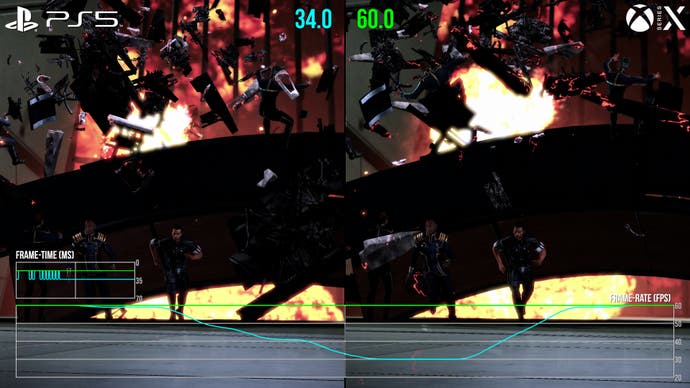Mass Effect Legendary Edition: PS5, Xbox Series X and Series S tested
Performance and quality modes compared.
There's a fair degree of controversy surrounding this one - does this remaster clash with the original creator's vision, especially when it comes to its lighting and presentation? Are some of the changes to gameplay and content appropriate or indeed desirable? While the discussion plays out, there are some things that are beyond dispute. Mass Effect Legendary Edition is a truly colossal undertaking - an ambitious package that updates Bioware's creation for the 4K era, while also making much-needed tweaks to the first game's controls. And for Digital Foundry, the process of looking at this game began with one simple question: what should be the focus for our coverage and how do we begin to cover it?
The developer itself has been very open about exactly how it has approached the remastering process with its visual upgrades, while explaining in-depth how it plans to change and rebalance gameplay aspects. Our focus therefore is to produce more of an overview of the remaster, and to see how it plays out across the new wave of console hardware. And that presents some interesting discussions points: the Legendary Edition is primarily designed for the last generation of console hardware. Enhancements for PlayStation 5 and Xbox Series consoles come with 'back compat plus' - which is essentially the last-gen game code running on the new consoles, with minor tweaks in place to define resolution and frame-rate targets.
In addition to testing the game on the new machines, we also went all the way back to the beginning, running Mass Effect 1 on Xbox 360. Creative vision aside, it's here where we begin to appreciate the scale of the effort. It's truly in the 2007 original where we see the greatest push to modernise the game. Controls are improved: the first game now adopts the tighter aiming mechanics of later games, with a smaller reticle and better feedback on bullet impact. It's honestly one of the main reasons to go back to it today. There is some restraint from Bioware that shows faith to the original design however. Taking cover behind walls is still automatic, for example, rather than using a button press to snap to a wall, as in the sequels. The context-sensitive cover just isn't as dependable as Mass Effects 2 and 3's approach - but for balance, perhaps, it had to stay put.
The list of upgrades beyond that is extensive. Bug fixes, gameplay rebalancing, reworked auto-saving points, and loading times that barely last a few seconds on each console just scratch the surface. There's a smart launcher interface on booting the app too, letting you resume your last played game in the trilogy. HDR is included, as well as the push to 4K resolutions all round - and on PC the code's adjusted to allow for 240fps caps, 21:9 aspect ratio screens (though only in gameplay alas), and better controller integration. On a technical level, the improvements are legion. Beyond resolution, texture mapping is updated across the board in all three games - the team stating that over 30,000 individual assets are upgraded, some via AI upscaling, others reworked by hand. Every surface of each planet is retooled and upgraded to ensure a decent presentation on a modern 4K display.
The upgrades are vast and far-reaching in the remaster. Shadow quality is boosted, geometry tweaked, and we have improved anti-aliasing to support the 4K picture on Series X, S and PS5. Effects are all revamped too, with the inclusion of some impressive volumetrics work, vastly improved grass shaders and even screen-space reflections replacing some rough water shaders of the original. The downside? Well curiously, on Series X and PS5 versions running at 60fps, these reflected elements only update at 30fps - half the rate of the overall picture, which can look a little jarring in motion. In Series X's 120fps performance mode, the update is boosted to 60fps, at least, but it remains odd. Meanwhile, thankfully, the refresh on reflections is consistent at 30fps in Series S's quality mode (thank goodness -15fps would have been problematic).












Character presentation also required an extensive revamp. It's not simply in the way textures, or skin shaders are upgraded either - or even the updated modelling. All of those all play a huge part, but it's in how light reacts across faces in the remaster. Reworked skin and hair now react logically based on light direction and intensity, giving a more natural, diffuse look. According to Bioware, the remaster doesn't claim to use a physically-based model for lighting - but it's still a vast improvement in most scenarios. Materials like skin and plastic react to give more realistic results, backed by higher grade screen-space ambient occlusion to fill gaps with shade. It's a vastly higher resolution asset, and it shows throughout the game's huge cast.
All of these asset upgrades amount to one thing: a huge install size for the Legendary edition. In fact, the remastered trilogy comes in at 88GB on Xbox Series X, and 101GB on PS5 right now in European territories - a sizeable upgrade against the 23GB of all three games combined on Xbox 360. Textures, effects and shaders only account for a part of this big install - another big factor are the cutscenes. Many of Mass Effect's cinematics are pre-rendered - and so for Legendary Edition, we have a re-render of these pre-render, if you like. All are boosted to support 4K - running at 30 frames per second - and sport all of the engine-driven updates in textures, shaders lighting and shadows. It's a huge package as a result. Thankfully EA has thought ahead on the size demands here, and you can install each game in chunks from the front-end launcher, as needed.
So how does the new wave of consoles compare? Interestingly, native 4K - or something very close it - is the name of the game for the new wave of consoles, along with a push for 60 frames per second and beyond. Yes, quality and performance modes are included on all systems from Series X and PS5 at the top-end, right down to Xbox One and PS4 at the other extreme. The good news? The Legendary Edition looks identical between PS5, Xbox Series X, and even Series S. All enjoy the benefits of the remastered visuals with little compromise. Textures, shadows, lighting - even plant density and screen-space effects - look entirely identical. The difference comes down to performance. PS5 and Series X can run 4K at 60fps, while Series S caps at 30fps instead in its quality mode. Meanwhile, in performance mode, PS5 and Series S target 1440p60, while Series X aims for 1440p at 120fps instead.












Before we go in-depth on performance, it's worth noting that the sheer size of the Mass Effect trilogy included, spread across three consoles and two quality modes, means that our samples are necessarily limited to the opening few hours of each title. We'll start off with the quality mode where Series X is the strongest 4K60 performer of on console, with no dips under 60fps whatsoever. PlayStation 5 has some minor frame-rate dips and seems to struggle more with screen-filling transparency effects - the big explosive cutscene at the beginning of Mass Effect 3 being a good stress test. Meanwhile, Series S mostly sticks to its 4K30 target - however, again, taxing transparency effects can see performance tumble to the low 20s at its nadir. Dynamic resolution scaling is included too. Native 4K does seem to be the norm in most test samples on PS5 and Series X, but a 1944p pixel count did manifest in one area of our testing. Owing to the nature of DRS, further drops cannot be ruled out.
The frame-rate mode is intriguing for a number of reasons. Both PS5 and Series S target 1440p60, while Series X aims for 1440p at 120fps. Barring a drop from 4K in the quality mode, the presentation is essentially identical otherwise, the exception being screen-space ambient occlusion quality is dropped, with a lower precision effect in place on the frame-rate mode. Of course, exclusive 120fps gaming on Series X is a real coup for the machine but there is a catch - the delivery isn't as solid as I'd hoped, especially in the first Mass Effect's opener. Stretches of play will hit a sustained 120fps, but crucial locations like the Citadel sit between 80 to 120fps, with even the opening Eden Prime mission struggling to rise above 100fps for crucial battles. Again, dynamic resolution scaling is in play in this mode too, but it sadly can't always help it lock 120fps.
I will say that the first Mass Effect goes extremely heavy on volumetric effects early on - it's a taxing way to start the game. For me though, it's simply too variable on fixed refresh displays, though Series X's VRR function will certainly help if your TV supports it. Fortunately, Mass Effect 2 and 3's opening segments fly without similar issues. In fact, excluding a crashing reading in Mass Effect 3's intro cut-scene, most of the big set-piece battles later on run without issue. There are a few uneven spots in Mass Effect 2 as well, but so far at least, nothing as drastic as the first game. The 120Hz mode is a neat bonus to have, but be warned it does have its rough points and I'd keenly recommend you keep VRR mode enabled.

Xbox Series S? Its 1440p frame-rate mode uses an adaptive v-sync, and so when it does drop beneath 60fps you get full-screen tearing to help minimise the impact to fluidity. Overall, it's mostly a solid 60, but you can see drops into the 50s. You get flashes of tearing and sub-60fps drops around the Citadel, as well as when using the grenade launcher in Mass Effect 2. Performance hits are rare, though still jarring after coming from the fluid Series X version. On the whole it's a solid release that at least gives 30fps and 60fps options, though each is prone to drops at points across the trilogy.
With PS5, we must remember that this is not a native application, meaning its somewhat beholden to limits imposed by PS4 Pro - but you do get a higher frame-rate. What this means is that 120fps is off the table, you simply get an even tighter lock to 60fps at its 1440p resolution that's almost perfect. It's one workaround to the frame drops in the 4K quality mode, but in my honest view here not a necessary one, and I'd recommend sticking with the higher resolution alternative. It's simply a better compromise between visuals and performance. All told, whether it's down to the backwards compatibility nature of the title or some other factor, Series X has many advantages over PS5 - a tighter grip on 4K60 in its quality mode and a 120Hz mode that, while inconsistent, can be salvaged with VRR.
All told, while my experience with the Legendary Edition is limited owing to the sheer scale of the project, my impression is the remaster is a marked success in modernising the trilogy. 14 years on from the release of the first game, the ambition and the effort that has gone into it is staggering. It's not just the improved visuals, but how the revamp makes each game more playable: UI changes and control tweaks included. It's a perfect jumping on point for the series if you missed the boat on release - and equally, it's just great to see 4K60 as an option on Series X and PS5 out of the gate. Perhaps with a few refinements here, performance can be locked down on the Series S and PS5 versions, but it's mostly a win in its delivery. How the other machines - and PC - fare is another story for another day perhaps. But in the here and now, the Mass Effect magic is still palpable - and this is a recommended release.


